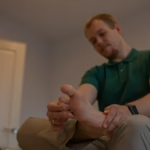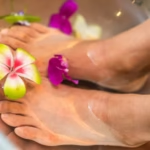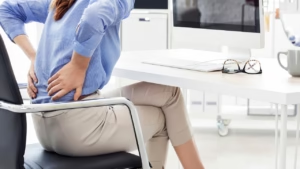The worst upsets a person can experience deal with Tailbone Pain When Sitting. Many people in the world feel it. According to research, about 15% of adults and many pregnant women experience pain in the tail-bone area. Physio Whisper helps people feel good by alleviating musculoskeletal issues using physiotherapy. This text explains its causes, relates a real-life incident with it, and guides easy ways to relieve Tailbone Pain When Sitting.
Tailbone Pain When Sitting: A Story of Unexpected Change
Early one bright day, normal household noises filled the air. A hopeful young mother had been greeting a fine morning with teas and mediations while a pain down the tailbone greeted her with a jerk; a sudden sharp pain that took her for a moment and inhalation.
Her mood flipped by now. Only the previous day was she running about with energy and joy; now, with every sitting position, the pain seemed to increase. Her family observed her shrinking smile with concern. Not much would escape her lips, but her eyes told a thousand tales of worry and distress.
Almost 12% of women experience tailbone pain while sitting during pregnancy. Changes in hormones, shifting weights, or spending too long in the same position can be precursors to such pain. This story teaches us that even a day or so of pain may need emergency management or a good change of habit.
Tailbone Pain When Sitting: Global Statistics and Main Causes
Pain around the tailbone affects people of any range, and global studies reveal that up to millions experience the pains near their coccyx. Some quick facts:
- Incidence: Up to 15% of adults experience pain in the area of the tailbone when they sit for prolonged periods.
- Effects of Pregnancy: About 12% of pregnant women say they experience tailbone pain when they sit.
- Lifestyle Influences: Long sitting, poor posture, and lack of muscle strength make it worse.
At our musculoskeletal physiotherapy practice, we find that Tailbone Pain When Sitting may have varying causes:
- Muscle Inbalances: Tight or weak muscles may impose excess pressure on the tailbone.
- Postural Defects: Slumping or inappropriate sitting positions increase the stress on the coccyx.
- Injury or Trauma: Falls or trauma could affect the tailbone.
- Pregnancy-related changes: During pregnancy, weight gain and shifting balance can alter the feel of pressure distribution when sitting.
All these insights help to select the right methods for alleviating pain. For other reliable facts visit Mayo Clinic.
Tailbone Pain When Sitting: Simple Ways to Find Relief
Some small adjustments can make all the difference when it comes to alleviating your Tailbone Pain When Sitting. Clear uncomplicated methods are applied at Physio Whisper to get you feeling better. Here are some steps to try:
- Posture Adaptations:
- Upright posture and relaxed shoulders.
- Use a void cushion to release pressure from the tailbone.
- Gentle Stretching:
- Take some gentle stretches of the lower back and hips.
- These stretches relieve tension from taut muscles.
- Strengthening:
- Exercises targeting your core are emphasized.
- With the use of controlled yoga and Pilates, one may have proper back support.
- Warm Compressess:
- Warm the tailbone area with warm packs.
- For better blood circulation and cut pain, this will add the last touch.
- Changing Seating:
- Continue to sit with ergonomic chairs that give the necessary support to the body.
- That would also be a good cushion.
Each of these tips works with your body’s natural healing. Our team gives you every step clearly and in a friendly manner. For further information on posture and ergonomics, visit the National Institute for Occupational Safety and Health (NIOSH).
Tailbone Pain When Sitting and Pregnancy: Special Care
Pregnancy is a time of great change to the body. Pain in the tailbone while sitting, or cocoose pain, is common in most pregnant mothers since extra care is needed during this special time. Thus, some tips can be assigned for pregnancy:
- Gentle Exercises:
- These exercises should be chosen to be low-impact, not abusing the tailbone.
- Work on developing core strength with safe moves.
- Deep Breathing:
- Try and practice slow, full deep breaths to relax your body.
- Your breathing exercises relieve gathered tension.
- Cushioning and Support:
- Be mindful of your posture while you sit and stand during pregnancy.
- It helps distribute weight evenly when you’ve good posture.
- Custom Cushions and Supports:
- Sit on specially designed pregnancy cushioning.
- It gives extra support to the lower back and tailbone.
All of those work safely and effectively while pregnant. They help reduce pain while keeping you comfortable. For more specific information about pregnancy pain management, check the American Pregnancy Association.
Tailbone Pain When Sitting: Everyday Self-Care Tips
Home health care is significant. Minor adjustments in your routine can help manage Tailbone Pain While Sitting. Self-care is easy:
- Follow a Routine:
- Work on set times for sleeping and eating.
- Supporting routine can relieve stress.
- Work Smart:
- Select a chair with good lumbar support.
- Make sure the desk height is adjustable.
- Stay Active:
- Get up from your desk and walk or do gentle stretches throughout the day.
- This keeps the muscles soft and loose.
- Eat, Drink, and Be Merry:
- Keep drinking water.
- Eat a well-balanced diet that is vitamin-inclusive.
- Breathe and Be Present:
- Small meditations or deep-breathing exercises are a great way to calm the body and mind, even if only for a couple of minutes a day.
With that sort of simple change, you can start setting the groundwork for healing. Simple habits can result in great benefits. Visit KidsHealth for more family-oriented self-care solutions.
Lifestyle Changes for Long-Term Relief
Long-lasting relief often comes from altering some of the daily habits that govern your life. We want to see you embrace an overall lifestyle that decreases Tailbone Pain When Sitting over time. With that in mind, consider some of the long-term changes:
- Exercise:
- Incorporate walking, swimming, or biking.
- Regular movement strengthens and prevents pain.
- Stress Reduction:
- Try mindfulness, meditation, or almost any gentle yoga.
- Lower stress can mean decreased muscle tension.
- Posture Awareness:
- Always consider your posture, sitting or standing.
- Good alignment allows proper support for your spine and tailbone.
- Don’t Overwork Yourself:
- Listen to your body: Take breaks.
- Increase your activity gradually, staying mindful of prevention for flare-ups.
These changes are simple but effective. One small step here or there will lead you toward a healthful, pain-free tomorrow. Our goal is to see you build a life where Tailbone Pain When Sitting becomes a dim memory.
Our Vision for Your Recovery
At Physio Whisper, we believe every little step counts. To ease your Tailbone Pain When Sitting and to restore your quality of life, we work very hard. Our methodology applies smart techniques alongside caring support.
Every exercise, every posture check, every deep breath takes you one step closer to a pain-free life. Studies show that targeted physiotherapy reduces musculoskeletal pain by 30%, and this statistic drives our determination to provide nothing but the best for our patients.
We intend to accompany you in this journey. We make our approach straightforward and friendly, tailoring our techniques to your individual needs. As steady progress is made, you will gain comfort and confidence.
To discover how our personalized approach can help you in your recovery, you can visit our homepage.
In a very real world where every step towards a pain-free life counts, what small choice will you make today to help you start feeling better?














